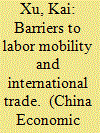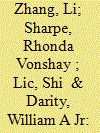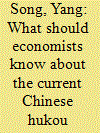| Srl | Item |
| 1 |
ID:
133191


|
|
|
|
|
| Publication |
2014.
|
| Summary/Abstract |
This paper quantitatively evaluates the potential impacts of removing China's Hukou system on the world economy. By denying migrant workers the right to health benefits and housing, China's Household Registration (Hukou) system presents a significant distortion to the Chinese labor market that discourages the reallocation of its labor from agriculture to non-agriculture. I find that the elimination of Hukou could increase China's real income per capita by about 4.7%. Moreover, although for most countries the impact of removing Hukou is modest (less than 1% changes in real income per capita), substantial changes in real income could take place for China's small neighboring economies. For example, the decreases in real GDP per capita are 2.7%, 3.2%, and 4.1% for Bangladesh, Sri Lanka, and Vietnam, while Thailand stands to enjoy a 3.8% increase in its income.
|
|
|
|
|
|
|
|
|
|
|
|
|
|
|
|
| 2 |
ID:
149771


|
|
|
|
|
| Summary/Abstract |
Since the end of the 1980s, the number of migrants working in the urban labor market has increased dramatically. However, migrant workers are treated differently from urban workers. In this paper we examine the labor market discrimination against rural migrants from the point of view of wage differentials using CHIP-2007 data. We apply Jann pooled method to deal with index number problem and use Heckman two step model to correct selection problem when decomposing the wage gap. The decomposition results show that a significant difference in wage gains persists between the two groups as late as 2007. In 2007 migrants only earned 49% of urban workers' income and 17% of the wage gap cannot be explained by observed factors. In detail, differences in educational attainment, work experience and distribution across industry, occupation, and ownership of enterprises account for most of the explained wage gap.
|
|
|
|
|
|
|
|
|
|
|
|
|
|
|
|
| 3 |
ID:
133197


|
|
|
|
|
| Publication |
2014.
|
| Summary/Abstract |
This article explains the current hukou system in China and provides the most recent evidence on the impact of the hukou system on the Chinese labor market and economy. By a comprehensive literature survey, this paper shows that the hukou system plays in two major roles in current China. First, workers with different hukou face different costs of living in cities and have different access to government-provided public services and welfare programs in the urban areas. Migrants with rural and non-local hukou working in the Chinese big cities have no or little access to welfare programs provided by local city governments. Second, there exists labor market discrimination against rural hukou holders in cities, especially in the urban high-wage sector such as state-owned enterprises. The current hukou system has a negative impact on rural-to-urban migration in China as well as on economic efficiency and equality by reducing the expected benefits associated with migration.
|
|
|
|
|
|
|
|
|
|
|
|
|
|
|
|